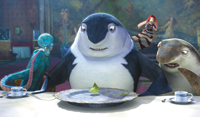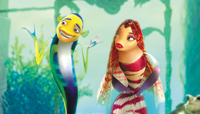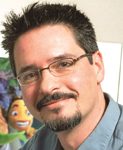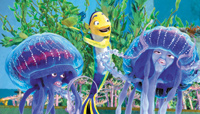
Mob scene: Animators took special care to mimic voice actors' key characteristics, such as Robert DeNiro's mouth movements and Will Smith's hairline and facial features.
|
CITY BENEATH THE SEA
Lead CG supervisor Kevin Rafferty wanted "incredible depth and detail" in Shark Tale's undersea city, Cooper says. "Each window is a unique shape" in the coral buildings, and this detail called for more massive computing power to blend the amorphous shape of natural coral with the repetitive structure of city buildings. There are also funkier neighborhoods with distinctive brownstone dwellings with stoops.
Even decorative props like kelp and sea grass undulate realistically in the backgrounds. Particulate matter, the detritus that floats through any natural underwater environment, also got special attention - just the right amount was used to subtly remind viewers they were submerged.
An effect Cooper gets a kick out of is the bubble trails that follow characters' movements throughout the film. The rule of thumb there is that the bubbles subtly trail off behind fish departing a scene, following the line of action to impart a sense of speed and motion.

Ambient occlusion, bounce lighting and subsurface scattering are among the effects that bring a new subtlety to Shark Tale's lighting.
|
WORKIN' IN THE WHALE WASH
The film's "Car Wash" sequence, featuring a remake of the hit song, is a prime show-stopping example of character animation, effects and music coming together on a grand scale. Cooper's bubbles play an important role as a giant sperm whale gets a bath at our hero Oscar's place of employment. Here the suds that worker fish scrub into the whale customers behave in a predictable foamy way, and then disperse into the seawater.
Supervising animator Fabio Lignini holds the "Car Wash" scenes as one of his favorites, given the close to 40 animated characters working and performing in the sequence. "We had a choreographer come in," Lignini says, "who did the dance routines for all the different stations of the car wash. She did a very thorough job of giving distinct moves to the waxing turtles and the soapers, like Oscar." Groups of dancing fish in this number were given slight variations to their synchronized moves for added realism. This is easy to do in Maya, Lignini says, "providing the rigs are all similar and will accept animation from another rig.
"The whole film was new for us," Lignini says. "It's the first CG animated film done fully here in Glendale." Lignini, who hails from Brazil, was one of five supervising animators working with about 60 animators. Animation teams tended to number about six, but the whale wash sequence required 10.

Fabio Lignini
|
THOSE LIPS, THOSE EYEBROWS
The animated characterizations achieved by DreamWorks' team are sure to resonate with adult viewers, from Angie's (Renee Zellwegger) subtle facial expressions to the uncanny resemblance voice actors Will Smith, Robert DeNiro and Martin Scorsese share with their animated counterparts. Regarding DeNiro, Lignini says, "the animators did a real good job of mimicking his mouth shapes, which are very distinctive with the turned-down corners. With Oscar, the design looks like Will Smith with the hairline and the half-closed lids. Scorsese, with the thick eyebrows and fast speaking, we tried to match with fast gestures." If, while recording dialogue, an actor came up with a useful motion or gesture, the animators would capitalize on that, too.
Lignini is one of the many veteran DreamWorks animators who made the switch from cel to CG, and Shark Tale - his first 3D work - required "pretty intensive training" in Maya for the whole team. Lignini sees 3D software as an extension of the animators' artistry: "It's still 90 percent the animator's skills and craft, independent from the medium. It's still about creating the poses, the expressions, the acting. We use mirrors, we also use references from the actors who recorded the voices, and we studied some footage of sharks in the ocean. When we're planning a specific scene, we act it out, timing ourselves doing the action many, many times." Lignini's team would also create very simple thumbnail pencil drawings in sequence to plot out a scene prior to animating.
The "five-family sit-down" sequence Lignini oversaw was long and complex; it mixes humor and tension and required about eight animators. Here, the heads of some rather threatening species -hammerheads, leopard sharks, great whites, killer whales, swordfish -confront Oscar, who has wrongfully made a name for himself as a "shark slayer."

Doug Cooper
|
Even underwater, the characters - particularly whales and sharks - had to give a sense of weight, Lignini says. "One of our challenges is to keep things from looking very plastic-y, weightless and float-y. And our fish are not 100 percent fish like in Finding Nemo. We have a city with props, tables and chairs; they sit around and eat and talk."
KEEP ON CUTTING
Editing a CG film begins in the storyboard stage and carries through to the finish... the process can last over two years. Supervising editor Nick Fletcher is another veteran of numerous cel-animated DreamWorks films who has made the transition to CG. Avid has been instrumental in extending his artistry and influence in today's animation workflow. "When I first started doing animation editing it was considered a low form of editing," Fletcher says. When it comes down to the final animated material, he says, there is very little extraneous material that needs cutting.
Working digitally on the Avid today, "the main part of the job of the animation editor is to cut and re-cut and re-cut the storyboard sequences at the very beginning so we can map out and define as clearly as possible what it is the animator is going to be animating. We pre-edit the movie."

Rasta fish: Shark Tale's two jellyfish hit men were the toughest to animate in 3D due to their diaphanous undulations
|
Fletcher feels this process can be even more complex than live action editing because "we aren't given the raw material to work with."
A story like Shark Tale's will be fleshed out with drawings by storyboard artists working with the director on short sequences. Shark Tale had three directors: Vicky Jenson, Bibo Bergeron and Rob Letterman. Storyboard artists would pin their drawings up and pitch favorite characters or bits to the directors and a group of people, including Fletcher, who in turn give their input.
Then the drawings are digitized into Fletcher's Avid. Some sequences may not yet have visuals and play simply as dialogue until drawings are ready. "It's really only when we get it downstairs into the Avid that it really starts to play - or not. That's true of Shark Tale's gags. For all the work that's done in the storyboard department, it's somehow only when we start cutting it and working with it that we find out if something's working or not for the first time." Fletcher and his editors cut the storyboard to a rough dialogue track and once they are happy with a sequence, they will show it to the directors, producers, even studio head Jeffrey Katzenberg for feedback.
"We're constantly finessing," says Fletcher, who is from Wales. "There's a lot of fun to be had." Fletcher loves to find spots where a missing close-up or a reaction shot would work and point that out to the directors.
Next, the layout department has a pass at it. "In CG the layout department has an even more important role now because they are actually building the sets the animators are going to use and they work out the blocking of the action."
Once the layout pass is complete, the cut can go to the animators. "By then," Fletcher says, "things are getting pretty close to the timing we need. After the animation pass is done, it goes into the lighting department where the final touches are done."